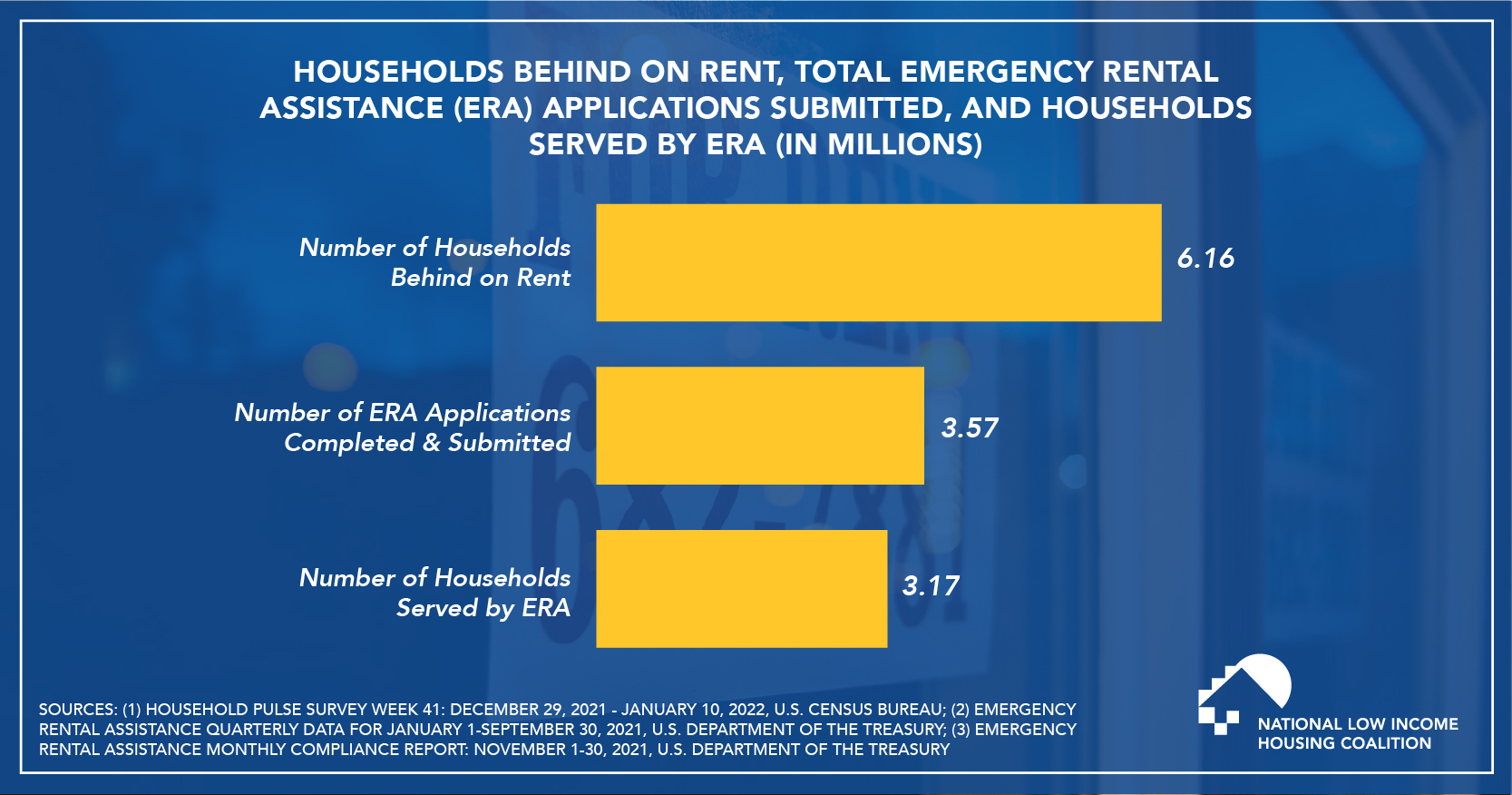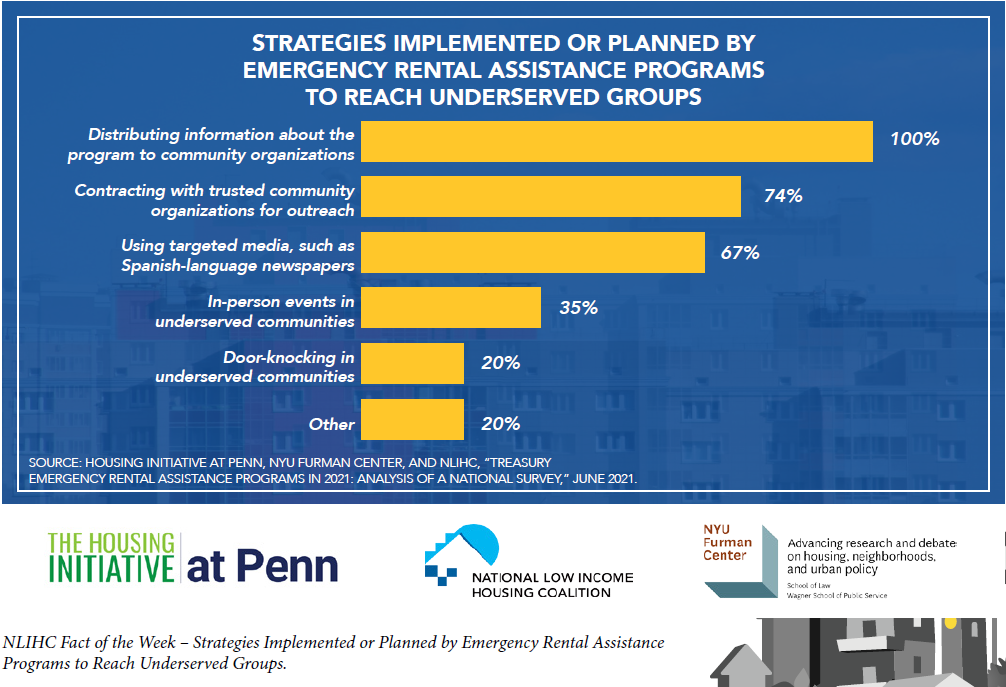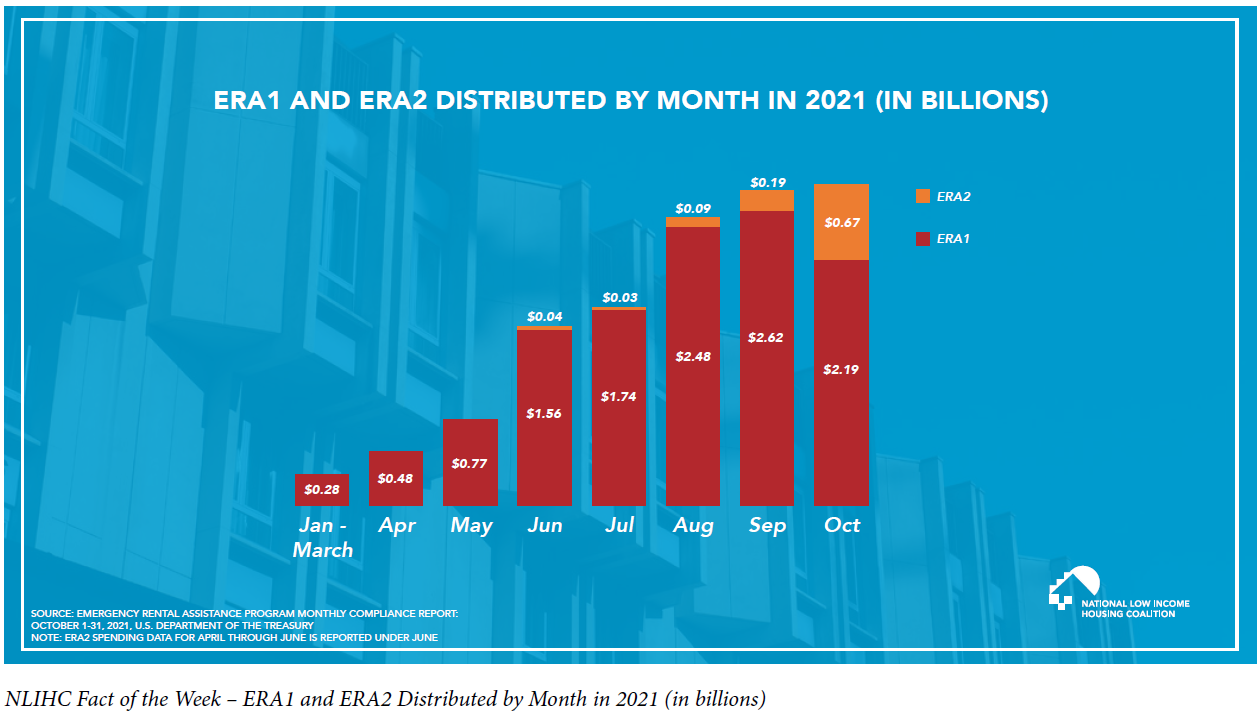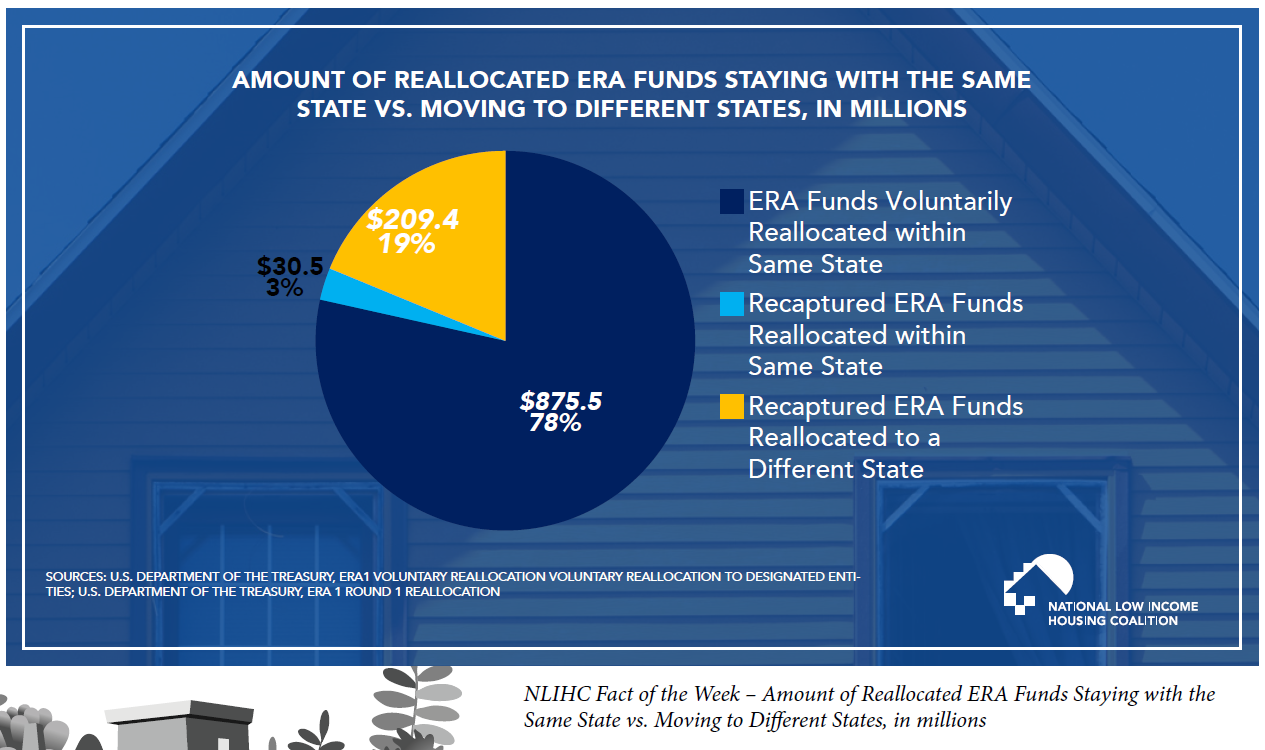The Emergency Rental Assistance Program
The Emergency Rental Assistance Program – commonly called ERAP or ERA – is administered by the U.S. Department of the Treasury (usually known as “Treasury”). Through the program, Treasury gives funding to states (including the District of Columbia), territories, tribal governments, and local governments to disburse to landlords and renters in need. While Treasury provides rules (or “guidance”) for running ERAP and disbursing funds, each individual ERA program is unique. Through its guidance, Treasury has encouraged state and local ERA programs to adopt practices – including self-attestation, direct-to-tenant assistance, categorical eligibility, and fact-specific proxies – that help ensure that ERA money gets to tenants and landlords in need in time to prevent evictions. You can learn more about these practices on page 11 in the PDF.

NLIHC Fact of the Week – Households Behind on Rent, Total Emergency Rental Assistance (ERA) Applications Submitted, and Households Served by ERA (in millions)
ERA: Who is eligible? What is covered?
The $46.55 billion in emergency rental assistance (ERA) that was passed by Congress came through two different pieces of legislation, the “Consolidated Appropriations Act of 2021” (enacted in December 2020) and the “American Rescue Plan Act” (enacted in March 2021). The ERA made available through the first piece of legislation is known as “ERA1” and that made available through the second piece of legislation is called “ERA2.” Eligibility for ERA varies based on whether the funding is distributed through ERA1 or ERA2.
Households are eligible for ERA1 funds if one or more individuals has qualified for unemployment benefits or can attest in writing that they have experienced a reduction in household income, incurred significant costs, or experienced other financial hardship due directly or indirectly to the pandemic.
Households are eligible for ERA2 funds if one or more individuals has experienced a reduction in household income, incurred significant costs, or experienced other financial hardship during or due directly or indirectly to the pandemic.
Most programs allow applications to be started by either tenants or landlords. If a landlord starts the application, the tenant must meet all eligibility requirements and cosign the application submitted by the landlord. However, tenants can still be paid directly by programs even if a landlord is not cooperative in the application process.
At least 90% of the ERA funds received by any state or local program must be used for direct financial assistance, such as rent, utilities and home energy costs, and other expenses related to housing. Funds can be used to pay back money owed for utilities or rent as well. A portion of the funds may also be used to support housing stability services, such as case management, housing counseling, and tenant/landlord mediation. For individuals receiving assistance, payments – including past and future payments – can be made for no more than 18 months in total.
Households that demonstrate a risk of experiencing homelessness or housing instability are also eligible for emergency rental assistance. This group includes low-income tenants – that is, those with incomes less than 80% of area median income (AMI) – though the Department of Housing and Urban Development (HUD) has the authority to adjust eligibility to include additional households.
Accessing rental assistance
If you are a renter looking for assistance with rent or utilities, visit https://nlihc.org/rental-assistance and use the searchable database to find a Treasury Emergency Rental Assistance program near you. It is important that you apply immediately – before programs run out of funding – and that, if eligible, you take steps to benefit from tenant protections tied to ERA programs that delay or prevent evictions.
Using Emergency Rental Assistance to support people experiencing homelessness
ERA funds can also be used to help people who are experiencing homelessness by paying for relocation costs, security deposits, future rent, application fees, and temporary hotel stays.
When people apply for rental housing, they often need to provide proof that they will be able to pay a security deposit and future rent. To help individuals demonstrate that they can pay the deposit and rent, the Treasury Department allows ERA programs to provide a “commitment letter” to prospective landlords stating that the applicant will have access to future rental assistance. The commitment letter specifies the amount of financial assistance the ERA program will pay the landlord if they enter into a lease with the applicant.
Using commitment letters is an important way for ERA programs to help people who are currently unhoused, individuals escaping domestic violence, people transitioning from incarceration or foster care, and other people who are at risk of experiencing homelessness or housing instability.
Program administrators must work with trusted community-based organizations to help people experiencing homelessness apply for ERA and obtain safe, affordable housing. Some landlords may refuse to accept the commitment of an ERA program to provide assistance on behalf of a tenant. ERA grantees and housing advocates should educate landlords about the commitment letter process and find ways to incentivize landlords to accept prospective tenants.

NLIHC Fact of the Week – Awareness of Federal Emergency Rental Assistance Programs Among Renters Who Have Missed a Payment Since March 2020 in Homes Owned by Small-Scale Landlords
Successful Emergency Rental Assistance Applications – Know Your Rights!
by Andy Heidt, program manager for housing policy and programs, Wisconsin Community Action Program Association (WISCAP)
Creating tips for a successful emergency rental assistance (ERA) application is not an easy task. Different states, cities, and counties have different requirements, making the process complicated despite the excellent guidelines provided by NLIHC and others, including the U.S. Department of the Treasury. Still, there are some tips that you should be aware of and that can help no matter where you live:
- If you are provided with an ERA application checklist, follow it carefully.
- Make sure you have an effective method for communicating with your ERA worker. Is it by phone? Make sure your voicemail is set up (and not full). Is it by email? Text? Will you be receiving updates on your application? Or will you have to follow up on your own? Programs that allow photos of required information, including images of signatures that can be texted, make life easier for all parties, especially tenants.
- Ask questions! If self-attestation is allowed but your program is still asking for documentation, ask why! If your application is denied, ask why! Often, programs will not provide you with this information unless you ask.
- Get help from an advocate. Legal aid organizations or local elected officials from your city or town government might be good resources. You can find a list of legal aid resources here and here.
- Work with your landlord. I know, I know: it’s not always possible, and it’s rarely easy. But if you do have a good relationship with your property manager, you should use it. Collaborative applications in which the tenant and landlord work together are the easiest to process successfully. Local non-profit organizations and social service agencies can provide additional assistance helping you connect with your landlord.
- KNOW YOUR RIGHTS! Housing needs to be a human right, but it’s not considered one. Even so, tenants and renters do have certain rights, and there are many places where you can learn about them. To learn more about your rights, check out some of the resources from the National Housing Law Project, including HUD Housing Programs: Tenants’ Rights and the excellent Tools for Tenant Advocates.
This process is harder than it needs to be, but it is important that you know about it. We need to stay stable in our homes so that we can rise above the struggle to survive – and thrive!

Equitable Distribution of Emergency Rental Assistance
Long-standing health inequities and social inequities like residential segregation mean that people from racial and ethnic minority groups, particularly Black and Latino households, are disproportionately impacted by COVID-19, economic hardship, and social vulnerability. The U.S. Department of the Treasury (Treasury) Emergency Rental Assistance (ERA) Program has provided direct financial assistance to help renters stay safely in their homes amid the COVID-19 crisis and its economic fallout. The ERA Program must address racial equity while also reaching households and communities that have been the hardest hit by COVID-19 and the economic consequences of the pandemic.
Recent data from the U.S. Census Bureau’s Household Pulse Survey for December 2021 and January 2022 suggest approximately 15% of renter-households were behind on rent. Renter-households of color, particularly Black and Latino renter-households, were more likely to have fallen behind on rent: 26% of Black renter-households were behind on rent in early December compared to 20% of Latino renter-households, 14% of Asian renter-households, and 9% of white renter-households. Compared to their need, Latino and Asian renter-households have been less likely to apply for emergency rental assistance: 15% of Latino and 7% of Asian renter-households have applied for rental assistance compared to 27% of Black renter-households and 9% of white renter-households. This disparity was reflected in a similar pattern among households receiving emergency rental assistance: Latino and Asian renter-households were less likely to receive emergency rental assistance relative to their need. The findings likely indicate gaps in the abilities of emergency rental assistance programs to conduct outreach to different households and support households that speak languages other than English. Though these data provide a picture of how emergency rental assistance has been distributed generally, that picture is limited, insofar as the data apply broadly to all emergency rental assistance programs, including programs that are not funded through Treasury’s ERA program.

Data from Treasury would provide richer information about types and amounts of assistance at a more granular scale. Treasury collects data from all local programs on key ERA outcomes, such as application rates, acceptance rates, and average amounts of assistance, and breaks this data down by gender, race, and ethnicity. Low application rates among specific populations could indicate a need for further outreach and revised communication strategies, while high incomplete or denial rates could signal barriers within the application and approval processes. Program improvements based on these metrics would ensure that funds are getting out quickly and equitably to the low-income renters most in need. Yet Treasury has yet to release these detailed data points. Such data are necessary for evaluating potential racial disparities in the distribution of ERA funds both nationally and within each jurisdiction. For this reason, NLIHC has urged Treasury to release these data quickly.
ERA Program Features and Spending Patterns
The Department of the Treasury Emergency Rental Assistance (ERA) Program has provided $46.55 billion to help low-income renters stay in their homes. By the end of November 2021, the department’s ERA programs had distributed $15.9 billion in direct financial assistance to approximately 3.2 million households. Even so, spending patterns among ERA programs have been uneven. While around 150 programs have spent most of their initial ERA funds, other ERA programs continue to spend slowly, with approximately 60 programs still having spent less than one-third of their initial ERA allocation.
Differences in key program-design features may help explain the uneven performance among ERA programs. New research from the National Low Income Housing Coalition and the University of Pennsylvania’s Housing Initiative at Penn provides a preliminary analysis of key ERA program-design features and spending outcomes. The report finds that programs that allow renters to verify their own documents – a process known as “self-attestation” – run especially smoothly.
Another program-design feature that reduces the burden of paperwork is “categorical eligibility,” in which a person’s eligibility for other income-qualified benefit programs makes them eligible for ERA. For example, being eligible for the Supplemental Nutrition Assistance Program (SNAP) can make a person eligible for emergency rental assistance. “Fact-specific proxy” is a similar program-design feature. It allows programs to determine ERA eligibility on the basis of the neighborhood where a person lives or other available facts about their situation.
Programs using self-attestation or other tools to reduce documentation, like categorical eligibility or fact-specific proxy, had generally spent a greater share of their money by September 2021 than programs that had not. Furthermore, programs that made changes to allow for more documentation flexibility seemed to have better spending outcomes. For example, programs that adopted self-attestation between the end of June and the end of September 2021 spent on average a greater share of their allocation (34%) during these months than programs that did not (25%). What’s more, these programs were more likely to be top spenders of ERA during that time. Yet even despite the emerging preliminary evidence that these flexibilities support spending, only 63% of ERA programs allow for some form of self-attestation.
Uneven initial allocations may also help explain uneven spending performance in some jurisdictions. According to an NLIHC report, Emergency Rental Assistance Spending and Performance Trends, several high-spending state programs have significantly more need than their initial ERA allocations will likely cover. State grantees in New York, California, Illinois, and New Jersey, for example, spent 83% to 100% of their state’s initial ERA allocation but have served fewer than 10% of low-income, housing cost-burdened renter households statewide. In contrast, states that received the small-state minimum and spent their funding quickly have served far higher proportions of housing cost-burdened, low-income renters and so likely have less need for additional resources. To address the problem, the Treasury Department can redirect excess funds from low-spending programs to high-spending programs through a process known as “reallocation,” which is discussed in the next article.

The ERA Reallocation Process
The U.S. Department of the Treasury (Treasury) is required by law to recapture Emergency Rental Assistance (ERA1) money from state and local programs with excess funds and send those funds to programs that need more money. This process, called “reallocation,” began on September 30, 2021. Reallocation is a way to ensure ERA is available in areas with the greatest needs and the capacity to distribute these resources. This is particularly important for states like California, New York, New Jersey, and Illinois, in which there are more applicants than can be assisted with current funding. Due to the way money was distributed at the beginning of ERA1, small states, like Wyoming, received a higher share of money per person. For example, New York’s population is nearly 33 times larger than Wyoming’s population, but New York received less than seven times the amount of ERA1 funding received by Wyoming ($1.28 billion for New York and $200 million for Wyoming). Reallocation can help adjust some of these discrepancies in funding.
Treasury released guidance on the ERA1 reallocation process in October 2021. Programs that did not “obligate” – a measure that includes both spent and committed funds – at least 65% of their ERA1 funding by September 30 were required to submit a Program Improvement Plan to Treasury by November 15, 2021. In their program improvement plans, programs had to address whether they had (1) adopted policies recommended by Treasury (e.g., self-attestation or eviction diversion programs); (2) enacted policies not supported by Treasury; (3) identified barriers to distributing ERA; and (4) identified ways to improve their program.
Grantees that did not obligate 65% of their funds and did not meet a 30% spending threshold by September 30 were determined to have “excess funds.” The amount of funds recaptured was based on the difference between a grantee’s spending and the 30% threshold. The spending threshold increases each month, and Treasury plans to reallocate funds every two months. Programs can also voluntarily give their funds to another program within their state. Grantees that obligated more than 65% of their initial allocation by September 30, 2021, are eligible for reallocated funds.
Treasury released data in January 2022 about ERA1 grantees that voluntarily reallocated their funds or had their funds recaptured. These data also include where funding was sent. Treasury’s announcement initiated the first of several rounds in which Treasury will recapture “excess” ERA1 funds from programs that did not meet the required spending benchmark and redistribute those funds to programs in need.
In the first round of reallocation, more than $1.1 billion was reallocated, with $905 million going to grantees in the same states. Only 19% of the $1 billion in reallocated funds crossed state lines. Wisconsin, North Dakota, Indiana, Louisiana, and Tennessee all voluntarily gave up more than $100 million of their allocations. Idaho, Montana, and Delaware had the largest amounts of funding recaptured involuntarily, with $33 million, $22 million, and $11 million, respectively, being recaptured.

Because most of the reallocated funds were given up voluntarily during the first round, most of these funds remained in the same states. This is promising news for slow-spending states that were able to reallocate their funds locally, because many local grantees have been more efficient than their state program in spending ERA allocations. As a result, spending may pick up in states like Georgia, Arizona, Louisiana, Tennessee, and Wisconsin, where large amounts of funding were reallocated within the state. The small amount of funds available for reallocation across state lines, however, meant that some states with significant needs received far less than they requested. Grantees that received less money than requested may have the opportunity to receive additional funds in future rounds of reallocation, though it is still unclear how Treasury is prioritizing certain states and cities in the reallocation process.
Any ERA1 funds that have not been obligated by March 31, 2022, may be considered excess funds and may be reallocated to other programs. Treasury will not start reallocating ERA2 funds until March 31, 2022.
Read NLIHC’s fact sheet on ERA reallocation to learn more: https://bit.ly/3nBRNnl